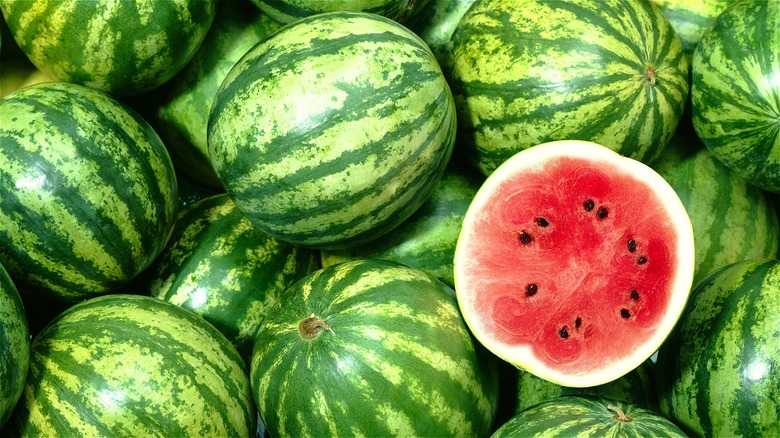Here's How To Tell If Your Watermelon Has Gone Bad
Enjoying a bowl of fresh juicy watermelon is a popular and delicious way to cope with the sweltering heat of summer. Ice-cold slices of this bright pink fruit rehydrate your body and provide your taste buds with sticky-sweet enjoyment. Whether you enjoy watermelon cut directly from the rind or made into refreshing watermelon salad, you want ripe and juicy watermelon that's also safe to eat.
Like any other fruit, watermelon is perishable. This vibrant fruit eventually reaches the point of no return if not consumed within the recommended time frame, which can change depending on where watermelon is stored. Whole melons typically last a week at room temperature, but pre-cut or prepared melon should be kept in your refrigerator and consumed within five days.
To ensure you're next whole watermelon or pre-sliced container of fruit is safe to eat, use your five senses to detect signs of spoilage. Watermelons with dark or moldy spots should be discarded. Flesh that has a slimy feel and sharp or sour taste should also be thrown away. Unfortunately, watermelon can also spoil without noticeable signs of mold or soft spots. An off-putting smell when you cut into this sizable fruit is an indication that it may not be safe to eat, as well as other indicators of potential decay that may not be so obvious.
Signs of deterioration in whole watermelons
Before you buy and cut into your next whole watermelon, know what to look for in terms of spoilage so you can avoid consuming fruit that has potentially gone bad. Check whole melons for cuts, bruises, and soft spots. Watermelons with obvious signs of decay such as a dark or heavily bruised rind should be thrown out. Soft spots are also a sign of deterioration and potential mold growth.
Beyond scouring for obvious dark spots, look for cracks that are fizzing. Your watermelon may run the risk of exploding if you see any liquid bubbling from cracks or breaks in the outer skin. Since watermelon is over 90% water, this fruit's inner juices can sour and ferment in time, especially in high heat conditions. In some cases, this can cause watermelons to burst with little warning.
Luckily there are a few ways to minimize your chances of consuming watermelon that has gone bad — or have one blow up in your face. Whole watermelons can stay fresh for up to 10 days when stored at a cool room temperature. However, if you want your melon to last longer, stick it in your refrigerator. Refrigerated whole melons can last up to 14 days. When you're ready to cut into this bright pink fruit, still be on the lookout for any potential signs of deterioration. Once the watermelon has been cut, keep the fruit in the refrigerator and consume it within a week.
How to spot decay in pre-cut watermelon
Even though most packages of pre-cut watermelon come with a "best by" date, always keep containers of cut melon in cold storage and eat within five days. Always respect the expiration date listed on the packaging, but remember that cut melon can go bad without the deterioration being visibly noticeable. An airtight container may prevent mold growth, but slices or chunks that have become slimy or discolored should be tossed. If you happen to bite into a piece of watermelon that gives your tongue a bubbly, fermented mouthfeel or tastes sour, don't eat it and toss the rest. If there is an unpleasant smell hits you when you open the container, this is also a sign that your pre-cut melon is ready for the wastebasket.
As long you don't see visible signs of decay and you eat the watermelon in the suggested time frame, you can take a bite and judge the taste yourself. When in doubt, use your melon to judge the watermelon's freshness. Whether you like your watermelon plain or you're up for trying more creative watermelon ideas this summer, use these tips to make sure your watermelon is safe to eat.


